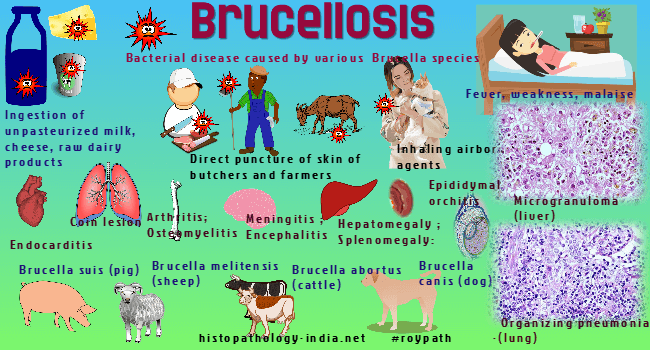|

Custom Search
|
|
Infectious Disease Online Pathology of Brucellosis
|

Syn: Undulant fever or Malta feverBrucellosis, a zoonotic disease caused by several species of the genus Brucella, may present as an acute severe systemic disease or as a subacute or chronic disease.Brucella are small, nonmotile, nonsporulating, gram-negative coccobacilli, which may or may not be encapsulated.Four species infect humans, each from its own animal reservoir.Brucella melitensis infects sheep and goats ; Brucella abortus , cattle ; Brucella suis , swine ; and Brucella canis, dogs.The disease is encountered worldwide and in all climates. Virtually every type of domestic animal and many wild ones are affected.The prevalence relates to occupational exposure, cultural or socioeconomic conditions resulting in close contact with animals, and consumption of contaminated milk or milk products.In much of the world the most common cause of infection is unpasteurized dairy products.In the arctic and subarctic regions humans acquire brucellosis by eating raw bone marrow of infected reindeer.Infectious mastitis of cattle may persist for years after recovery from the acute infection and remain a reservoir of Brucella.Products of abortion may contain organisms and are infectious.Urine, manure, and vaginal discharges are major sources of contamination.The incubation period is 5 days to several months. The onset of symptoms may be abrupt or insidious. The three clinical types of brucellosis are acute malignant, recurrent,and chronic (intermittent). The presenting features of acute malignant brucellosis resemble those of influenza, and include the sudden onset of high fever, chills, prostration, and somatic aches and pains. Lymphadenopathy and a palpable spleen and liver are the only localized findings. Death may be sudden, within a few days of onset, or after a few weeks of delirium and coma. Recurrent brucellosis (undulant fever) is characterized by influenza-like signs and symptoms that recur in wavelike relapses. The cycles may persist for weeks, gradually decreasing in severity. Chronic (intermittent) brucellosis is caused primarily by B. abortus. The onset may be acute or there may be gradual increase in malaise, weakness, weight loss, and vague somatic aches and pains. Fever is usually mild but weakness may be profound. The most common complications of brucellosis involve the bones and joints and include spondylitis of the intervertebral area of the lumber spine and localized suppuration in large joints. In addition, peripheral neuritis, meningitis, orchitis, suppurative endocarditis, and pulmonary lesions may develop. Bacteria enter through skin abrasions, the conjunctiva, oropharynx, or lung and spread in the bloodstream to the liver, spleen, lymph nodes, and bone marrow, where they multiply in phagocytic cells. A generalized histiocytic hyperplasia ensues with conspicuous noncaseating granulomas, causing lymphadenopathy and hepatosplenomegaly. Patients with chronic brucellosis may exhibit "coin" lesions in the lung resembling infectious granuloma of the lung caused by Histoplasma capsulatum or the lesions of tuberculosis. Acute bacterial endocarditis, myocardial abscesses and focal suppurative lesions in the myocardium are occasionally encountered.
The diagnosis must be confirmed by isolating the organism in culture or by serologic testing. Prolonged treatment with tetracycline and streptomycin is usually effective. Patients who recover from brucellosis are immune. Control of the disease depends on the elimination of brucellosis in animal reservoirs.
|
|
|

